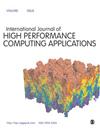通过可扩展的生成模型深度学习,实现新冠肺炎小分子药物的快速设计
IF 2.5
3区 计算机科学
Q2 COMPUTER SCIENCE, HARDWARE & ARCHITECTURE
International Journal of High Performance Computing Applications
Pub Date : 2021-05-03
DOI:10.1177/10943420211010930
引用次数: 21
摘要
我们提高了质量,减少了生产用于小分子抗病毒设计的机器学习模型的时间。我们的全球异步多级并行训练方法可扩展到整个Sierra,效率高达97.7%。我们训练了一种新颖的基于字符的Wasserstein自动编码器,该编码器在23分钟内对16.13亿种化合物进行了训练,产生了更高质量的模型,而之前的技术需要一天的时间对100万种化合物进行训练。将培训时间从一天减少到几分钟,将模型创建瓶颈从计算机工作周转时间转移到人类创新时间。我们的实现实现了318个PFLOP,占半精度峰值的17.1%。我们将把这个模型纳入我们的分子设计循环,从而产生更多样化的化合物;寻找新的候选抗病毒药物可以改善并减少合成待在实验室测试的化合物的时间。本文章由计算机程序翻译,如有差异,请以英文原文为准。
Enabling rapid COVID-19 small molecule drug design through scalable deep learning of generative models
We improved the quality and reduced the time to produce machine learned models for use in small molecule antiviral design. Our globally asynchronous multi-level parallel training approach strong scales to all of Sierra with up to 97.7% efficiency. We trained a novel, character-based Wasserstein autoencoder that produces a higher quality model trained on 1.613 billion compounds in 23 minutes while the previous state of the art takes a day on 1 million compounds. Reducing training time from a day to minutes shifts the model creation bottleneck from computer job turnaround time to human innovation time. Our implementation achieves 318 PFLOPs for 17.1% of half-precision peak. We will incorporate this model into our molecular design loop enabling the generation of more diverse compounds; searching for novel, candidate antiviral drugs improves and reduces the time to synthesize compounds to be tested in the lab.
求助全文
通过发布文献求助,成功后即可免费获取论文全文。
去求助
来源期刊
CiteScore
6.10
自引率
6.50%
发文量
32
审稿时长
>12 weeks
期刊介绍:
With ever increasing pressure for health services in all countries to meet rising demands, improve their quality and efficiency, and to be more accountable; the need for rigorous research and policy analysis has never been greater. The Journal of Health Services Research & Policy presents the latest scientific research, insightful overviews and reflections on underlying issues, and innovative, thought provoking contributions from leading academics and policy-makers. It provides ideas and hope for solving dilemmas that confront all countries.

 求助内容:
求助内容: 应助结果提醒方式:
应助结果提醒方式:


